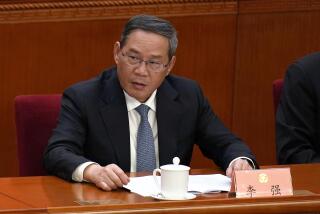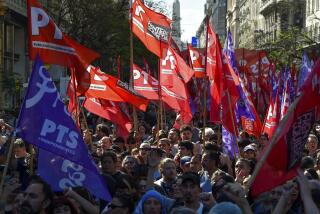China’s Attempt at Price Reform Hits Roadblock : State Slows Movement in Face of Corruption, Public Uneasiness, High Inflation
- Share via
BEIJING — For the past decade, market-oriented reforms and openness to the world have brought rapid, sometimes overheated economic growth to China, but the reform movement now faces a severe test. Economic imbalances, corruption, inflation that is the worst since 1949 and deep public unease have forced the leadership to revise its timetable.
The Communist Party Central Committee recently endorsed an attack on inflation--now running at an annual rate of about 25%--as the government’s top priority. And as part of this battle, Chinese leaders want to slow economic growth to an annual rate of 8%, down from about 11% so far this year.
The pace of price reform--the freeing of prices to bring them into line with market values--is also to be slowed. An existing two-tier system in which some goods are sold at controlled prices while others sell at market prices will not be quickly eliminated.
Vice Premier Yao Yilin, a key architect of the slowdown, said last month that China has freed half of all prices. But according to the official New China News Agency, he said the government is not prepared to decontrol “food grains, cotton, edible oil and other farm produce, as well as some important means of production.”
Some analysts who believe that the rapid freeing of virtually all prices is the key element in China’s reforms view the price reform slowdown as a major setback to the entire reform effort.
But China’s leaders emphasize that reforms are moving forward in many fields, including enterprise management and ownership, the legal system, finance, housing, labor and foreign trade. Investment, meanwhile, is being aimed at bottlenecks in key areas such as energy and transportation.
Zhao Ziyang, general secretary of the Communist Party, said in an early October statement explaining the significance of last month’s Central Committee decisions that it is “not exactly correct” to think that the party has decided to slow the pace of overall reform.
Seeks Better Conditions
Zhao, according to a report by the New China News Agency, emphasized the need to combat inflation and corruption and to tie wages more closely to productivity.
“Our present task,” he went on, “is to continue the measures that have helped boost the country’s economy in the ongoing reform and opening to the outside world. At the same time, we shall eliminate what the people resent. . . . What we are doing now to overcome these problems is just designed to create better conditions for continuing our reform.”
Premier Li Peng made a similar statement earlier this month.
“Some foreigners have said that China is falling back from its reform,” he said, according to the New China News Agency. “Such a saying is not based on facts and is unrealistic.”
The outlines of China’s current policies were worked out by top leaders in what are said to have been heated discussions this summer at the seaside resort town of Beidaihe.
Some reports in the Hong Kong press have described these debates as a battle pitting Zhao, widely viewed as the strongest advocate of rapid price reform, against more cautious leaders such as Li and Yao.
In mid-August, at the end of the Beidaihe meetings, the official news media reported that the Communist Party Politburo had approved a tentative five-year plan for price and wage reforms. This plan called for most prices to be freed within five years, for enterprises to be made responsible for their own profits and losses, and for an attack on inflation.
Although officials had said in mid-July that no major price increases were planned for the rest of this year, the Politburo announcement contributed to rumors that prices would soon go up. This led to widespread incidents of bank runs and panic buying in the second half of August.
On Aug. 30, the State Council announced specific anti-inflation measures. These included construction cutbacks and decisions to raise interest rates, limit growth of the money supply and tighten credit.
Last month’s meeting of the Central Committee, a 175-member body that is nominally superior to the Politburo but in practice usually ratifies its decisions, endorsed the broad outlines of the plans announced in August.
“Price reforms will be conducted at a smaller pace next year, and efforts must be made to ensure that next year’s commodity price increase rates will be lower than this year’s,” a communique said, summing up the Central Committee session.
Increased Autonomy Urged
“Without a rational price structure, the establishment of a basis for a new economic system is out of the question. However, deepening the reform is not merely a matter of adjusting prices, but involves comprehensive reforms in various fields, especially the reform of enterprises--large and medium-sized state-owned enterprises in particular.”
The communique said that in the coming year special attention should be given to increasing the autonomy of state enterprises and experimenting with the sale of stock in such enterprises.
Some analysts believe that the decision to give the fight against inflation higher priority than price reform is a serious defeat for Zhao.
Both Zhao and China’s paramount leader, Deng Xiaoping, made statements a few months ago in favor of stepping up the pace of price reform. They have backed down, but opinions vary as to whether this is a damaging defeat for Zhao.
At the beginning of this year, Zhao was quoted in the official media as saying that no major price reforms were planned for 1988 and that work should focus on enlivening enterprises. The party has now extended these themes into 1990.
Some Chinese intellectuals believe that events of the past few months, by demonstrating the need to soak up excess savings, may actually work in favor of such reforms as stock sales and the commercialization of housing.
The sale of shares in state enterprises is seen not only as a way to increase the autonomy of enterprises, to draw capital to well-managed units and to motivate employees, but also as helping to reduce demand for consumer products by drawing savings into long-term investments.
China’s first bankruptcy law, which provides rules for shutting down or reorganizing unprofitable enterprises, comes into effect Tuesday, providing an important part of the legal framework for a more market-oriented business system.
“Those enterprises with poor management, who lose money and come out with bad economic results will go bankrupt,” State Council spokesman Yuan Mu declared at a press conference Friday.
Bankruptcies are expected to contribute to a modest rise in unemployment above the present estimated rate of 2%, Yuan said.
“Some of those bankrupt enterprises will be merged into well-run enterprises, some will have to auction their properties and some will have to shut down,” Yuan said. “As for those workers who lose jobs because of enterprises going into bankruptcy, government policy is that those workers will be redeployed by creating other job opportunities for them, by retraining to learn new skills and by being absorbed by the enterprises that their original enterprises are merged into.”
The government is working to improve a social security system designed to guarantee the basic living expenses of unemployed workers, Yuan added.
Early October reports in the official media have emphasized privatization of state-owned housing as another key aspect of China’s reforms.
Minister of Construction Lin Hanxiong was quoted in the China Daily as saying the sale of apartments is “the key to solving the housing shortage in China.”
Most urban housing is state-owned and is assigned to individuals by their work units at very low rents, usually no more than $1 or $2 a month. This means that housing is essentially a welfare benefit, and the construction of housing does not pay for itself.
The government intends to build more apartments for sale, and to accelerate sales of existing apartments, Lin said. About half of China’s state-owned urban housing could appropriately be sold, at prices likely to average about $40 a square yard, according to a recent People’s Daily article. The state could recover about $50 billion from the sales, the report said. It added, however, that the purchase of housing will not be widely attractive until rents are raised.
Reforms are also moving forward in other areas. Last month, in keeping with plans to separate governmental and economic functions, what used to be the ministries of coal, petroleum and nuclear power were turned into state-owned corporations.
These corporations will have independent accounting systems and assume responsibility for their own profits and losses, according to a report by the New China News Agency.
What has been the overwhelming dominance of the state-owned sector of the economy is also being gradually reduced. This is because the output of privately and collectively owned enterprises, which deal primarily with goods bought and sold at market prices, is growing more rapidly than that of the state-run sector.
For the first nine months of this year, the state enterprises’ share of China’s industrial output was 64.5%, down from 67.3% for the same period of 1987.
More to Read
Sign up for Essential California
The most important California stories and recommendations in your inbox every morning.
You may occasionally receive promotional content from the Los Angeles Times.









